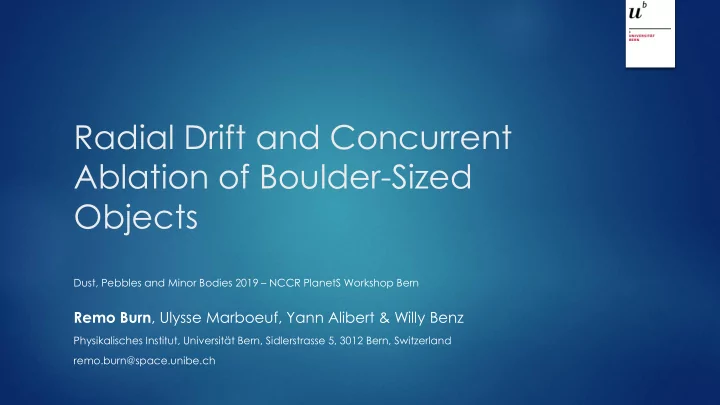

Radial Drift and Concurrent Ablation of Boulder-Sized Objects Dust, Pebbles and Minor Bodies 2019 – NCCR PlanetS Workshop Bern Remo Burn , Ulysse Marboeuf, Yann Alibert & Willy Benz Physikalisches Institut, Universität Bern, Sidlerstrasse 5, 3012 Bern, Switzerland remo.burn@space.unibe.ch
Introduction 2/24
Introduction Icy bodies crossing the snowline due to radial drift Caused by gas drag Quantify efficiency of water transport Focus on H 2 O ice line (i.e. the snowline) 3/24
Boulder size range Pebbles and Cobbles sublimate fast and drift slow (e.g. Schoonenberg, Ormel 2017, Drazkowska 2017) Boulders with r ≳ 1m drift fast and take longer to lose ice Planetesimals (r ≳ 200m) drift slower than snowline They never cross it by gas induced drift 4/24
Methods 5/24
Cometary Nucleus Model Model from Marboeuf 2008, Marboeuf et al., 2012 1-D mode used Heat, gas and dust grain transport Sublimation/Condensation of volatiles Dust mantle formation / removal possible Coma Surface T Gas + grains Cometary Disk Model Nucleus Model R, ρ silicates H 2 O H 2 O 6/24
Radial Drift − 2𝑏𝜃Ω Quadratic Regime 𝑒𝑏 𝑡 𝑒𝑢 = 𝑡 2 − 2𝑏𝜃Ω Epstein or Stokes (laminar) Regime 1 + 𝑡 2 𝑡 𝜍 𝑡 𝑆Ω 2𝑆 6𝑤 𝑢ℎ𝑓𝑠𝑛 Stokes Number 𝑡 = 𝑢 𝑡 Ω = × 1, 3𝜇 , 𝜍 𝑤 𝑢ℎ𝑓𝑠𝑛 Δ𝑤 7/24
Results (BURN ET AL. SUBMITTED TO A&A) 8/24
Single Boulder 9/24
Sublimation Model 10/24
Size Dependence 11/24
Size Dependence 12/24
Size Dependence 13/24
Size Dependence Assume a size distribution 𝑜 𝑛 𝑒𝑛 = ቊ𝐵𝑛 𝛽 for 𝑛 ∈ [𝑑 𝑚 , 𝑑 𝑣 ] 𝑒𝑛 0 else 𝑑 𝑚 = 1 kg 𝑑 𝑣 = 1 × 10 9 kg Integral over all included masses Mean in time evolution of the disk 14/24
Dust Mantle 15/24
Different Disks 16/24
Applicability 17/24
Collisions 18/24
Collision Rate «Stokes» collision rate (Safronov 1969) 2 𝑑𝑝𝑚 = 𝑜 𝑊 𝑛 𝑗 𝜌 𝑆 𝑢 + 𝑆 𝑗 2 Δ𝑤 1 + 𝑤 𝑓𝑡𝑑 Γ Δ𝑤 2 𝑛 𝑢 +𝑛 𝑗 2 𝑤 𝑓𝑡𝑑 = 2𝐻 𝑆 𝑢 +𝑆 𝑗 Integrate over all masses of impactors 𝑛 𝑗 Dust and larger particles settle to the midplane Balanced by turbulence 𝛽 Scale height is suppressed ℎ 𝑡 = ℎ 𝛽+𝑡 (Youdin&Lithwick 2007,Fromang&Nelson 2009, Birnstiel 2016) Stop settling at 1% of gas scale height 𝜃𝑤 𝑙 Relative velocity Δ𝑤 depends on radial and azimuthal contributions 1+𝑡 2 Neglected contributions: Settling speed, Turbulence, Brownian Motion 19/24
Collision Rates Γ 𝑑𝑝𝑚 (Collisions/yr) 𝑛 𝑢 Minimum Impactor Mass (g) 20/24
Erosion Erosion by collisions with smaller bodies: Total mass erosion rate for a drifting boulder with 𝑠 = 10 m 2 − 10 × 10 −2 % yr −1 Timescale of modelled process 100 – 1000 yr 21/24
Conclusions 22/24
Conclusion Boulders > ca. 10 m reach the same distance to the star (pileup) For self-similar size distribution (-1.83) of drifting bodies, the location of 50% water fraction is shifted by 2% Water presence limit closer by 15% than the standard one Independent of time and disk initial conditions Stable dust mantle has a huge impact on the location 50% closer to the star compared to standard ice line No sublimation from surface layer, need diffusion through surface layer 23/24
Outlook Take into account pressure of gas disk in a self-consistent way Adding H 2 , He to nucleus model Eccentric or scattered case Effects for bigger planetesimals Additional heating process Heat due to gas drag most significant Possible to see signature of this process in the future? Combination with pebble sublimation needed CO, CO 2 lines Could small boulders keep their size when sublimating (becoming fluffy)? 24/24
Recommend
More recommend